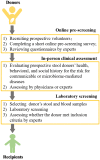Research Progress of Fecal Microbiota Transplantation in Liver Diseases
- PMID: 36836218
- PMCID: PMC9960958
- DOI: 10.3390/jcm12041683
Research Progress of Fecal Microbiota Transplantation in Liver Diseases
Abstract
A growing body of evidence suggested that gut microbiota is associated with liver diseases through the gut-liver axis. The imbalance of gut microbiota could be correlated with the occurrence, development, and prognosis of a series of liver diseases, including alcoholic liver disease (ALD), non-alcoholic fatty liver disease (NAFLD), viral hepatitis, cirrhosis, primary sclerosing cholangitis (PSC), and hepatocellular carcinoma (HCC). Fecal microbiota transplantation (FMT) seems to be a method to normalize the patient's gut microbiota. This method has been traced back to the 4th century. In recent decade, FMT has been highly regarded in several clinical trials. As a novel approach to reconstruct the intestinal microecological balance, FMT has been used to treat the chronic liver diseases. Therefore, in this review, the role of FMT in the treatment of liver diseases was summarized. In addition, the relationship between gut and liver was explored through the gut-liver axis, and the definition, objectives, advantages, and procedures of FMT were described. Finally, the clinical value of FMT therapy in liver transplant (LT) recipients was briefly discussed.
Keywords: chronic liver diseases; fecal microbiota transplantation; gut microbiota; gut-liver axis; liver transplantation.
Conflict of interest statement
All authors have no conflict of interest to declare.
Figures



Similar articles
-
Gut-Liver-Brain Axis and Alcohol Use Disorder: Treatment Potential of Fecal Microbiota Transplantation.Alcohol Res. 2024 Feb 1;44(1):01. doi: 10.35946/arcr.v44.1.01. eCollection 2024. Alcohol Res. 2024. PMID: 38322428 Free PMC article. Review.
-
Fecal Microbiota Transplantation in NAFLD Treatment.Medicina (Kaunas). 2022 Oct 30;58(11):1559. doi: 10.3390/medicina58111559. Medicina (Kaunas). 2022. PMID: 36363516 Free PMC article. Review.
-
Clinical Application and Progress of Fecal Microbiota Transplantation in Liver Diseases: A Review.Semin Liver Dis. 2021 Nov;41(4):495-506. doi: 10.1055/s-0041-1732319. Epub 2021 Jul 14. Semin Liver Dis. 2021. PMID: 34261137 Free PMC article. Review.
-
Fecal microbiota transplantation for treatment of non-alcoholic fatty liver disease: Mechanism, clinical evidence, and prospect.World J Gastroenterol. 2024 Feb 28;30(8):833-842. doi: 10.3748/wjg.v30.i8.833. World J Gastroenterol. 2024. PMID: 38516241 Free PMC article. Review.
-
Manipulation of the Gut-Liver Axis Using Microbiome Restoration Therapy in Primary Sclerosing Cholangitis.Am J Gastroenterol. 2019 Jul;114(7):1027-1029. doi: 10.14309/ajg.0000000000000191. Am J Gastroenterol. 2019. PMID: 30920413
Cited by
-
Gut-Liver-Pancreas Axis Crosstalk in Health and Disease: From the Role of Microbial Metabolites to Innovative Microbiota Manipulating Strategies.Biomedicines. 2024 Jun 24;12(7):1398. doi: 10.3390/biomedicines12071398. Biomedicines. 2024. PMID: 39061972 Free PMC article. Review.
-
The gut-liver axis in fatty liver disease: role played by natural products.Front Pharmacol. 2024 Apr 15;15:1365294. doi: 10.3389/fphar.2024.1365294. eCollection 2024. Front Pharmacol. 2024. PMID: 38686320 Free PMC article. Review.
-
Harnessing CD8+ T cell dynamics in hepatitis B virus-associated liver diseases: Insights, therapies and future directions.Clin Transl Med. 2024 Jul;14(7):e1731. doi: 10.1002/ctm2.1731. Clin Transl Med. 2024. PMID: 38935536 Free PMC article. Review.
-
Non-alcoholic fatty liver disease and gut microbial dysbiosis- underlying mechanisms and gut microbiota mediated treatment strategies.Rev Endocr Metab Disord. 2023 Dec;24(6):1189-1204. doi: 10.1007/s11154-023-09843-z. Epub 2023 Oct 16. Rev Endocr Metab Disord. 2023. PMID: 37840104 Review.
-
Gut Microbiota and Liver Regeneration: A Synthesis of Evidence on Structural Changes and Physiological Mechanisms.J Clin Exp Hepatol. 2024 Nov-Dec;14(6):101455. doi: 10.1016/j.jceh.2024.101455. Epub 2024 Jun 8. J Clin Exp Hepatol. 2024. PMID: 39035190 Review.
References
Publication types
Grants and funding
LinkOut - more resources
Full Text Sources
Research Materials

